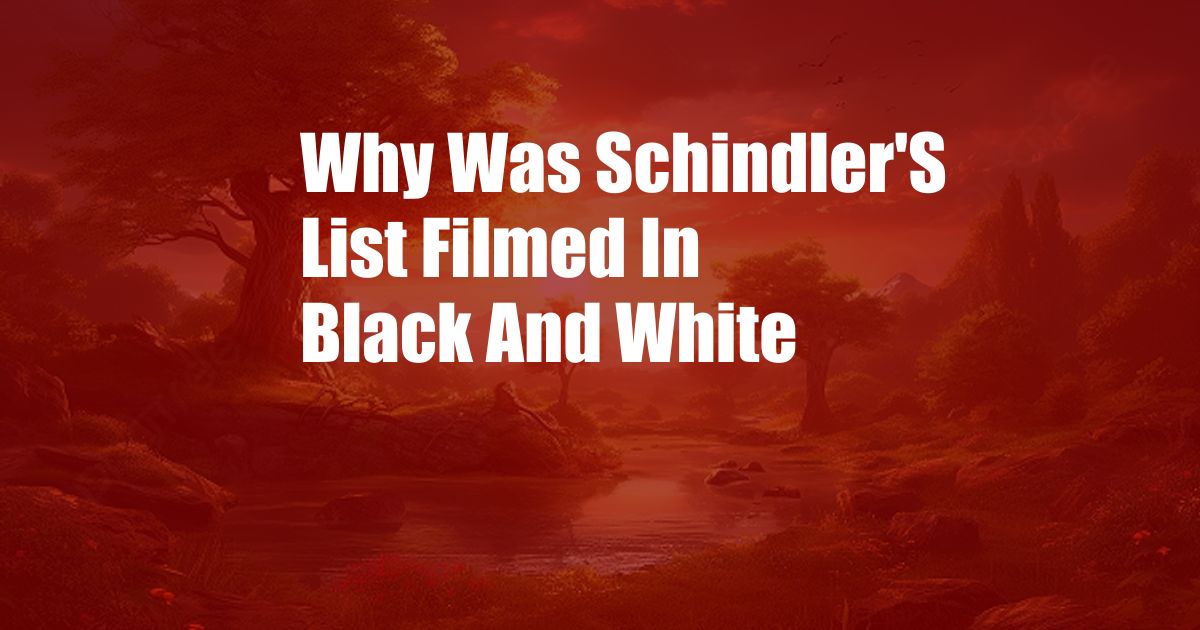
Why Was Schindler’s List Filmed in Black and White?
I remember the first time I saw Schindler’s List. I was in high school and was immediately struck by the film’s black-and-white cinematography. It was a stark and powerful choice that helped to create a sense of realism and authenticity. But I also wondered why director Steven Spielberg decided to film it in black and white when so many other Holocaust films had been filmed in color.
As I learned more about the film and Spielberg’s decision-making process, I realized that there were several reasons why he chose to film Schindler’s List in black and white. Spielberg’s black and white cinematography serves several distinct purposes, which serve the film in meaningful and innovative ways.
Symbolic Meaning of Black and White
One of the primary reasons Spielberg chose to film Schindler’s List in black and white was to create a sense of symbolism. The black-and-white cinematography helps to evoke the starkness and brutality of the Holocaust. The absence of color emphasizes the dehumanization of the Jews and the moral ambiguity of the situation. Spielberg’s use of black and white also helps distinguish Schindler’s List from other Holocaust films, fostering a specific viewing experience.
Historical Authenticity
Another reason Spielberg chose to film Schindler’s List in black and white was to create a sense of historical authenticity. Most of the footage from the Holocaust is in black and white, so using this format helped to create a documentary-like feel. Many archival black-and-white photographs exist from the Holocaust, so filming the movie in black and white provides a visual connection between the movie’s narrative and the grim realities of the time period.
Emotional Impact
Spielberg also believed that black and white would be more emotionally impactful than color. He felt that the lack of color would help to focus the audience’s attention on the characters and their stories. The use of color can influence the film’s narrative and add subtext, and, in Schindler’s List, the lack of color can heighten the emotional impact of the film’s subject matter.
Spielberg’s decision to film Schindler’s List in black and white was a bold and effective one. The film’s stark and powerful cinematography helped to create a sense of realism and authenticity while also highlighting the film’s moral themes.
Latest Trends and Developments
Since the release of Schindler’s List, there have been a number of other Holocaust films that have been filmed in black and white. Most notably, the 2008 film The Reader also used black-and-white cinematography to create a sense of historical authenticity. There have been other notable examples of films utilizing black-and-white cinematography to enhance their narratives, such as Roma (2018), Cold War (2018), and Belfast (2022), demonstrating that this technique remains a valuable tool for filmmakers seeking to explore historical events and human experiences through a distinct visual lens.
Tips and Expert Advice
If you are interested in filmmaking, here are a few tips to keep in mind when considering using black-and-white cinematography:
- Use black and white to create a specific mood or atmosphere. Black and white can be used to create a sense of nostalgia, mystery, or foreboding.
- Use black and white to emphasize the texture and form of your subject. Removing color can help to highlight the details and textures of your subject matter.
- Use black and white to create a sense of historical authenticity. Black and white can be used to evoke the look and feel of a particular era.
When used effectively, black-and-white cinematography can be a powerful tool for filmmakers. It can help to create a sense of realism, authenticity, and emotional impact.
FAQ
Q: Why did Steven Spielberg film Schindler’s List in black and white?
A: Spielberg chose to film Schindler’s List in black and white to create a sense of realism, authenticity, and emotional impact.
Q: What are some other Holocaust films that have been filmed in black and white?
A: Other Holocaust films that have been filmed in black and white include The Reader (2008) and The Pianist (2002).
Q: What are some tips for using black-and-white cinematography?
A: Some tips for using black-and-white cinematography include using it to create a specific mood or atmosphere, emphasizing the texture and form of your subject, and creating a sense of historical authenticity.
Conclusion
Schindler’s List is a powerful film that tells an important story about the Holocaust. Spielberg use of black-and-white cinematography was a bold and effective choice that helped enhance the film’s impact. The film remains a powerful reminder of the horrors of the Holocaust and the importance of fighting against hatred and intolerance.
Are you interested in learning more about filmmaking techniques? If so, I encourage you to do some research on the subject. There are many great resources available online and in libraries. You can also take classes or workshops on filmmaking. With a little effort, you can learn how to use black-and-white cinematography and other filmmaking techniques to create your own powerful films.